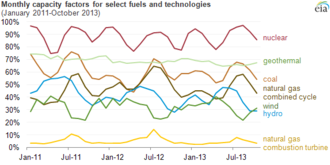
Back معامل الحمل Arabic Koeficient ročního využití Czech Nutzungsgrad German Factor de planta Spanish ضریب ظرفیت Persian Facteur de charge (électricité) French Fattore di capacità Italian 設備利用率 Japanese Capaciteitsfactor Dutch Fator de capacidade Portuguese

The net capacity factor is the unitless ratio of actual electrical energy output over a given period of time to the theoretical maximum electrical energy output over that period.[1] The theoretical maximum energy output of a given installation is defined as that due to its continuous operation at full nameplate capacity over the relevant period. The capacity factor can be calculated for any electricity producing installation, such as a fuel consuming power plant or one using renewable energy, such as wind, the sun or hydro-electric installations. The average capacity factor can also be defined for any class of such installations, and can be used to compare different types of electricity production.
The actual energy output during that period and the capacity factor vary greatly depending on a range of factors. The capacity factor can never exceed the availability factor, or uptime during the period. Uptime can be reduced due to, for example, reliability issues and maintenance, scheduled or unscheduled. Other factors include the design of the installation, its location, the type of electricity production and with it either the fuel being used or, for renewable energy, the local weather conditions. Additionally, the capacity factor can be subject to regulatory constraints and market forces, potentially affecting both its fuel purchase and its electricity sale.
The capacity factor is often computed over a timescale of a year, averaging out most temporal fluctuations. However, it can also be computed for a month to gain insight into seasonal fluctuations. Alternatively, it can be computed over the lifetime of the power source, both while operational and after decommissioning. A capacity factor can also be expressed and converted to full load hours.
- ^ "Capacity factor (net)". nrc.gov. Retrieved 2017-02-11.